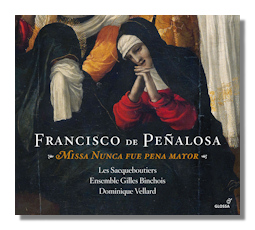
The Internet's Premier Classical Music Source
Related Links
- Latest Reviews
- More Reviews
-
By Composer
-
Collections
DVD & Blu-ray
Books
Concert Reviews
Articles/Interviews
Software
Audio
Search Amazon
Recommended Links
Site News
 CD Review
CD Review
Francisco de Peñalosa

- Missa Nunca Fue Pena Mayor
- Hymn "Sacris solemniis"
- Motet "Memorare Piissima"
- Tiento XIX
- Motet "O bone Iesu"
- Motet "Tribularer"
- Motet "Ave vera caro Christi"
- Motet "Transeunte Domino"
- Tres II
- Motet "In passione positus Iesus"
Les Sacqueboutiers
Ensemble Gilles Binchois/Dominique Vellard
Glossa GCD922305
The vocalists of the Ensemble Gilles Binchois (now over 30 years old) and Les Sacqueboutiers (instrumentalists) under the their accomplished French director Dominique Vellard have produced another enthralling and highly enjoyable CD on Glossa. It explores the lovely, confident yet unassuming choral music of the less well-known Renaissance Spanish composer, Francisco de Peñalosa; he lived from around 1470 to 1528. Of the dozen and a half or so CDs containing that composer's work four others are directed by specialist in the field Vellard, who was born in 1953. In fact, only a recording of Peñalosa's Missa Ave Maria peregrina, the motet Sacris Solemniis and this Missa Nunc Fue Pena Mayor by the Westminster Cathedral Choir under James O'Donnell on Hyperion Helios CDH55326, re-released in July 2011, is devoted entirely to Peñalosa.
Very little is known about Francisco de Peñalosa, although it's thought that his father (of the same name) accompanied Columbus to America in 1492/3. The composer, we do know, is associated with at least three major institutions – the royal chapel in the court at Aragon, Seville cathedral and the papal chapel of Leo X. Peñalosa's music is gentle without being genteel, unostentatious without being featureless and "quiet" without lacking character. His lines are graceful, unpretentious and rarely over-excite in the way that those of Victoria in the next generation sometimes do. Yet the music on this CD never lacks color.
In the way that skilled interpreters of the songs of Fauré, say, let the music speak for itself and refuse to add interpretative convolutions or glosses, so Vellard and the five-strong Ensemble Gilles Binchois with the rounded but never "plump" winds of Les Sacqueboutiers seem to be holding Peñalosa's scores up and suavely pointing to them as they perform. Yet there is nothing demonstrative or didactic in their interpretation. The great gift they offer to lovers of this rich and quietly-yielding music is that of taking its strengths for granted and appreciating, with us, the likely motivations of Peñalosa.
Oddly, this may be an acknowledgement by the performers (who are totally in control and on top of every aspect of the music which they perform here from first note to last) of the composer's high esteem – both throughout the Iberian peninsula and in the wider Catholic church… he was in Rome from 1517 to 1521, for instance. So it is, perhaps, that the singers are very relaxed, very informal in the style of their delivery. To say that they are unhurried is not enough. "Unpolished" completely wrong. Yet there are no moments of (unnecessary) tension. Their style is almost soothing – yet very far from soporific. Indeed, it seems to capture what (if Vellard is correct in this) is Peñalosa's gift for detachment blended with urbane confidence. At the same time, it's necessary to listen carefully in order to appreciate the subtleties of Peñalosa's melodic variety and richness. Vellard and his performers specifically sponsor such attention.
Every phrase of the singing on this barely hour-long CD does not need to be forced, strained, emphasized or underlined. The music is given time to breathe. And by the end of the music, you realize that Peñalosa has healthy and powerful lungs. Much of his (other) music has not survived. This CD seems to be hinting that, were more of it available to be studied and performed, we should be in the presence of yet another major presence of the Renaissance. Tess Knighton explains in her note for the CD how Peñalosa adapted the style of his writing to the genre… liturgical, motet, song – each often uses a different apparent inspiration and has different priorities.
On this CD the Mass, Nunca Fue Pena Mayor based on the then widely-known song by Juen de Urrede is interspersed with sacred hymns and motets – probably as the Mass would have been performed at the time. This works well; our attention does not lapse or become diluted. Rather, the experience after following Ensemble Gilles Binchois on the small journey represented by the Mass and other half dozen or so works is one of admiration and delight at Peñalosa's ability to (and own quiet delight in) work with sometimes simple musical (and textural) ideas to produce works of real beauty and unpretentious profundity. This is a major contribution to the repertoire and is well enough performed to make it a significant release to be snapped up immediately.
The booklet is well up to Glossa's usual high standards; it carries a useful introduction and the full texts in Latin, English, German, French and Spanish. The acoustic is closer than is sometimes the case with recordings of choral polyphony; especially since the recording was made in the Cathédrale Saint-Pierre-et-Saint-Paul de Maguelone, in France. It seems a balance that reflects the gentleness yet certainty of Vellard and the Ensemble's understanding of Peñalosa. Unless you specialize in this area of Spanish Renaissance choral polyphony, it's unlikely that you'll have much of Peñalosa's apparently modest yet quietly striking work. This is a wholly recommendable place to start.
Copyright © 2012, Mark Sealey.





















